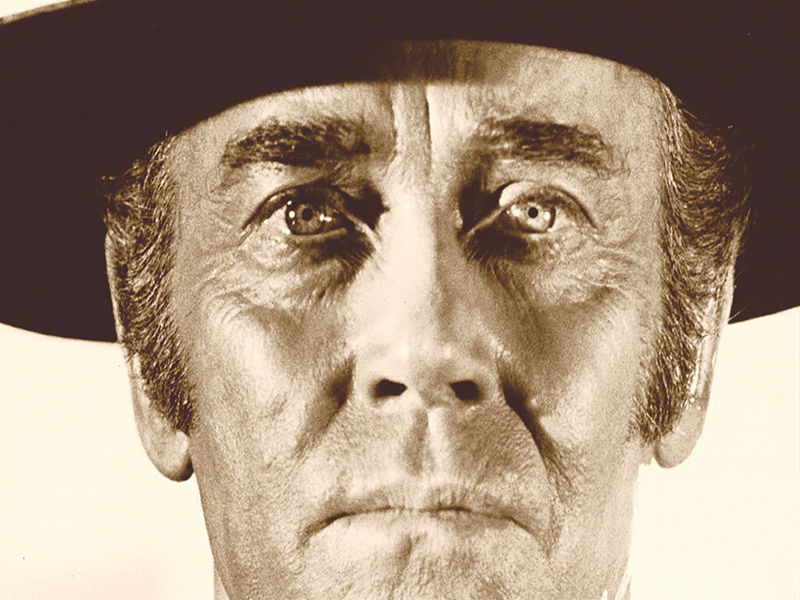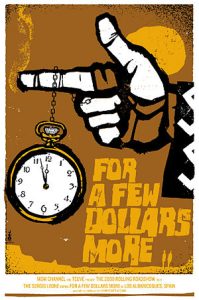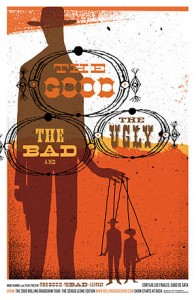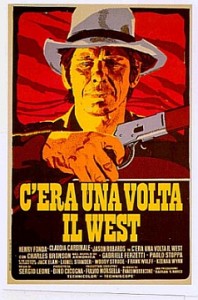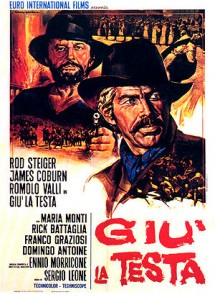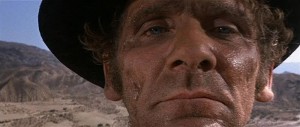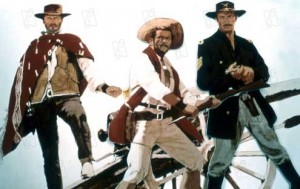Sergio Leone, born in 1929 in Rome, son of silent film director Vincenzo Leone, is best known for the creation of the spaghetti westerns. After making and writing several sword and sandal epics Leone decided to adapt Yojimbo, a samurai film by Akira Kurosawa. Leone turned it into the western A Fistful of Dollars in 1964, starring an unknown Clint Eastwood. Leone got much of his style, both in the complicated mise-en-scene and the use of Ennio Morricone’s music from Yojimbo (but not the trademark Kurosawa wipe edit). A Fistful of Dollars created the spaghetti western genre which encompassed more than 200 films, sharing the features of being created in Italy, frequently being filmed in Spain, featuring self-assured killers with no names, scores either by Ennio Morricone, or in his style, and, of course, the shootout.
Leone.
Leone’s style grew from imitating Kurasawa to his own style, which uses editing in combination with Morricone’s scores to create incredible emotional peaks, dramatic camera movements, and, his trademark, the extreme close-up of the eyes of the characters. After A Fistful of Dollars came For A Few Dollars More, and finally, the ultra-classic The Good, The Bad, and the Ugly. These are considered a series, since the main character is always Clint Eastwood, and he always lacks a name.
The next Leone film was made in 1968. Once Upon a Time in the West is a significant departure from Leone’s earlier westerns. This film is stylistically a spaghetti western, yet Leone directs this film with incredible care and beauty, matched only by Morricone’s classic score. Once Upon a Time in the West represents a quantum leap forward in film-making for Leone. The scenes are slow, beautiful, and powerful. The movie is a homage to the simplicity and honesty of the old west, doomed from the beginning of the movie to death by progress. This film, even more than the others, needs to be viewed in wide-screen (letterbox) format, since the atrocious pans and scans during crucial moments ruin the mood. This film is perfect, and needs to be seen in the perfect format.
After Once Upon a Time in the West, Leone made a different type of spaghetti western, one that deals with mercenaries and revolution: A Fistful of Dynamite (aka Duck, You Sucker). The genre is called a “Zapata Western”, and although Leone did not create it, A Fistful of Dynamite is one of the genre’s most memorable films. Another great example of the Zapata Western is Burn! (aka Quemada!), starring Marlon Brando, which is also essentially a film of this type, even though it is set on an isle off of South America in the 1700’s.
Finally, Leone in 1984 created his second masterpiece, Once Upon a Time in America, starring Robert De Niro and James Woods. The film is nearly four hours long, and was badly butchered for American release. The American version for some strange reason is still shown on A&E occasionally (strange because the American version is neither as artistic, nor as entertaining as the true version). The film is quite a departure for Leone, since it deals with Jewish gangsters in New York City’s Lower East Side. The film’s direction is slow, deliberate, impeccable, and intense. Of all Leone’s films, this film has the best plot, portraying the lifelong struggle of a mobster wrestling with his criminal side.
Leone’s first directorial efforts, beyond assistant director, came in the sword and sandal films. But he was unheard of until he unleashed A Fistful of Dollars upon the world. Dollars is about a silent stranger who’s only true concern is about where his next paycheck is coming from. He arrives in a rundown Mexican town in the clutches of a family war between two rival dynasties. The Baxters and the Rojos. The stranger manipulates both to his own end and leaves a rich man. Upon it’s release, Fistful was one of the biggest grossing Italian films of all time. It’s unprecedented success made Eastwood a star in Italy and upon it’s US release, in America as well.
US critics hated Fistful because of it’s highly stylized feel and extreme violence. Although it seems tame by our modern standards, it was very violent for it’s time. This is one of the most important aspects of both Leone’s films, and the Spaghetti Western. Violence. Leone wanted to show how vile the people of his film were and he even makes the hero only slightly less evil than the villains. Thus revolutionizing the western anti-hero. But his violence was extreme. He met with censorship problems in one early scene. The stranger shoots it out with henchmen under the employment of the Baxters. Leone stations the camera at the stranger’s hip so we see him shooting the henchmen from the point of view of his gun. It was against the rules back then to have the shot and the bullet hitting it’s target in the same shot. Leone also increased the kill count. Amongst this, he filmed gruesome beatings, and grotesquely disturbing massacres. He added more action and less talk. Leone was bored of all the talk in American westerns and wanted to speed things up. His characters say more by saying less. Instead, they give looks. Then they shoot.
After the success of A Fistful of Dollars, the Italian studios wanted more. So Leone went about starting a sequel. The aptly named, For a Few Dollars More. And with this film, Leone expanded on his style. The pace is slower and his trademark waiting and lulls before death are far more obvious and evermore present. And he also included another good guy. This was absent from the first one. In this film, two bounty hunters team up to eliminate the outlaw El Indio and his gang for the large sum of bounty money which rests upon their heads. Eastwood returns to his role as the Man with No Name alongside black clad Lee Van Cleef. This film is one of the highest ranked Spaghetti Westerns of all time and if my info is correct, the second highest grossing Italian Western of all time.
With this film, Leone adds a new character. A partner to the main character. After this film, there would never be just one hero. Always two or more. But the addition of a new gunman not only adds more killing, but a chance for Leone to closer examine relationships. In his westerns, Leone’s heroes are always weary of each other. Never trusting each other and often double crossing. But human nature is hard to fight. And greed taints many hearts in the Italian West. Leone’s partners’ relationships developed as time goes on. They form respect and sometimes, trust. If only for a moment. They are closest when they are in combat as it is what they do best, kill.
Rolling3.jpg
And still the producers and Italian public wanted more. So Leone again came up with more. What resulted is quite possibly the best western ever made, and maybe even the best film! The Good, the Bad and the Ugly. Three gunmen battle it out in Civil War torn New Mexico for a coffin full of gold. GBU also features Leone’s partnerships. The partnership in this film is further explored and more complicated. But what is truly amazing about this film is Leone’s scope and vision. He creates a Civil War which has been called one of, if not the most historically accurate depiction of the conflict ever put onto the screen. The musical score has since become extremely well known and is right up there with the Forgotten Pistolero as the most recognized of old western music.
With GBU, Leone has finally mastered his technique. He slows the pace even more so than in For a Few, but the quietness and suspicion that he so skillfully films before his shootouts is far more exciting and spectacular than any action scene. Just the way the characters move and how they act is so beautiful. But his action comes swift and quick and is far less amazing than the build up, but the shootings are the final act to every one of these great moments. The camera work in this film can be seen in all his other films. He mastered the crane shot and with his tedious attention to detail, he films even more spectacular scenes. The background action is key in these scenes. With this film, Leone films a low key and extremely simplistic story but on such a grand scale. The plot deals with a gold hunt but in between this, he films an entire Civil War. So ultimately, it is his scale that makes Leone such a remarkable director.
After Leone had finished and released GBU, he had tired of the western. He had said all he wanted to say. He wanted to start a gangster epic but producers still wanted more westerns. Paramount offered Leone a large budget and Henry Fonda whom he had wanted to work with all his career. So the end result was his longest, slowest, and grandest western, Once Upon a Time in the West. But unfortunately, the most flawed. But although these flaws are not overshadowed, the film’s strengths do deliver a satisfying end result. Anyway, the story is about a prostitute who’s family is massacred by railroad men. She soon meets and is befriended by two men, a mysterious stranger and an eccentric outlaw. Both protect her but one has a score to settle with Frank, the head railroad man.
Once Upon a Time in the West is a perfect example of Leone’s admiration and love of the classic American western. And just as in his previous westerns, he references his favorites. Only this time, they nearly fill the 2 hour 45 minute run-time. Leone loved westerns and especially those of Irish American director, John Ford, whose grand, picturesque, and extravagant storytelling abilities greatly influenced Leone. The first two Dollars films are relatively low on obvious references (to my eye) but GBU and Once Upon a Time… are chalked full of said references. Gone with the Wind was something of an inspiration for the Good, the Bad and the Ugly. Mostly because of it’s Civil War setting. But beyond just referencing past westerns, Leone used them to help create his own mythic western landscape. Leone’s west is violent, cruel and treacherous. But it is also epic, beautiful and vast. With his minimal budgets, he created his own world. One where violence ruled. But it is not the violence that is so important. It is the tense, quiet, slow waiting before the violence that is so exciting. One major ingredient in his world was music. As Sir Christopher Frayling states, it took the Italians to show what Horse Opera really meant. The spaghetti Western is an Opera of Violence. Where the beautiful music sets the tone. The emotion of a scene is not achieved solely through imagery, but through the music which truly captures emotion. So to sum up this thought, Once Upon a Time in the West is the best possible example of Leone’s west. And what Leone’s west really is, is a “violent, long, dreamlike meditation upon the mythology of the American old West.”
GiuLaTesta Poster2x HQ.jpg
After it was released, Once Upon a Time in the West bombed both financially and critically in the US, where it was to do probably the best business. The film was a success in Italy and France where it did very good business but not enough to recoup from the US failure. Leone would not direct another film for 3 years. Then he was offered to direct yet another western, Giu’ La Testa or Duck, You Sucker as it is (unfortunately) known as. Leone rejected directorial duties and his assistant director, Giancarlo Santi, was originally to direct while Leone would produce. But the stars, James Coburn and Rod Steiger, refused to be denied the pleasure of working with the one and only Sergio Leone. So he ended up with directional duties. Sucker is set in the Mexican Revolution. Two men, Juan Miranda and Sean, partner up and end up in the middle of the revolution. Sean wants to make a hero out of Juan but Juan only wants the money. Eventually, nobody wins.
Duck, You Sucker is Leone’s most political movie. This is quite obvious knowing it belongs to the political oriented Zapata Spaghetti Western sub genre. But the previous Zapatas seemed to glorify revolution and promoted social revolution. But Leone’s message here is decidedly different. At first look, it may seem as if he is glorifying revolution but by the end, it is obvious that he does not and did not glorify the revolution at all. He shows them for what they are. They are horrible conflicts where people are massacred in droves, families are destroyed, and friends are betrayed. It is dirty, depressing and violent. It is not something to take lightly and is quite horrible. Not something to be glorified. But all of the Leone’s westerns are political to some extent. As one Leone expert put it, “It was impossible to not be political in the 60’s. But Leone was far less concerned about politics than say Carlo Lizzani. Therefore, normal people, such as my self, will have a hard time spotting obvious political statements. But to put it plainly, it seems that the rich and powerful are shown in a unfavorable light. They represent greed and corruption.
Once Leone left his west behind, the Italian western started to wear itself down. The films were becoming very cliched, silly and formulaic. Nothing new was going to be introduced and it eventually simply vanished. Leone spotted this early. He is known to have hated the Trinity movies. The comedies which had been misinterpreted and eventually led to the end of the genre. But Leone wanted to show what these films had become, so he made My Name is Nobody with Tonino Valerii. His elegy on the end of the west and the western. A very appropriate goodbye to his beloved genre. Leone’s films were never liked by critics but the public thoroughly enjoyed them. He is the man responsible for perfecting the Spaghetti style and his contribution to the Spaghetti Western and Western in general is comparable to Orson Welles to film noir. A true auteur of film.

